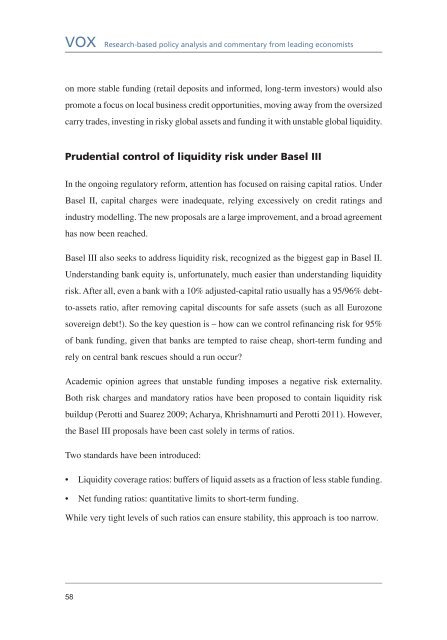Create successful ePaper yourself
Turn your PDF publications into a flip-book with our unique Google optimized e-Paper software.
VOX Research-based policy analysis and commentary from leading economists<br />
on more stable funding (retail deposits and informed, long-term investors) would also<br />
promote a focus on local business credit opportunities, moving away from the oversized<br />
carry trades, investing in risky global assets and funding it with unstable global liquidity.<br />
Prudential control of liquidity risk under Basel III<br />
In the ongoing regulatory reform, attention has focused on raising capital ratios. Under<br />
Basel II, capital charges were inadequate, relying excessively on credit ratings and<br />
industry modelling. The new proposals are a large improvement, and a broad agreement<br />
has now been reached.<br />
Basel III also seeks to address liquidity risk, recognized as the biggest gap in Basel II.<br />
Understanding bank equity is, unfortunately, much easier than understanding liquidity<br />
risk. After all, even a bank with a 10% adjusted-capital ratio usually has a 95/96% debtto-assets<br />
ratio, after removing capital discounts for safe assets (such as all Eurozone<br />
sovereign debt!). So the key question is – how can we control refinancing risk for 95%<br />
of bank funding, given that banks are tempted to raise cheap, short-term funding and<br />
rely on central bank rescues should a run occur?<br />
Academic opinion agrees that unstable funding imposes a negative risk externality.<br />
Both risk charges and mandatory ratios have been proposed to contain liquidity risk<br />
buildup (Perotti and Suarez 2009; Acharya, Khrishnamurti and Perotti 2011). However,<br />
the Basel III proposals have been cast solely in terms of ratios.<br />
Two standards have been introduced:<br />
• Liquidity coverage ratios: buffers of liquid assets as a fraction of less stable funding.<br />
• Net funding ratios: quantitative limits to short-term funding.<br />
While very tight levels of such ratios can ensure stability, this approach is too narrow.<br />
58














